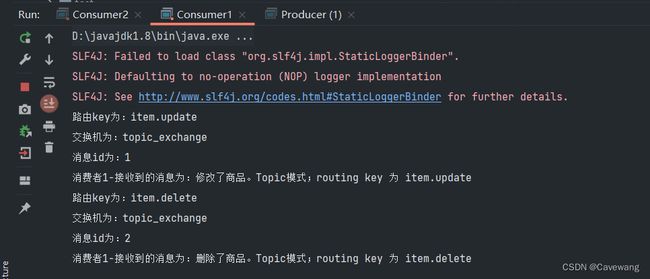RabbitMQ--Topics通配符模式实战
RabbitMQ--Topics通配符模式
- Topics通配符模式
- 示例工程
-
- 创建工程和添加依赖
- 编写生产者
- 编写消费者
-
- 消费者1
- 消费者2
- RabbitMQ模式总结
Topics通配符模式
Topic 类型与 Direct 相比,都是可以根据 RoutingKey 把消息路由到不同的队列。只不过 Topic 类型Exchange 可以让队列在绑定 Routing key 的时候使用通配符!
Routingkey 一般都是有一个或多个单词组成,多个单词之间以”.”分割,例如: item.insert
通配符规则:
- #:匹配一个或多个词
- *:匹配不多不少恰好1个词
举例:
item.# :能够匹配 item.insert.abc 或者 item.insert
item.* :只能匹配 item.insert


图解:
- 红色Queue:绑定的是 usa.# ,因此凡是以 usa. 开头的 routing key 都会被匹配到
- 黄色Queue:绑定的是 #.news ,因此凡是以 .news 结尾的 routing key 都会被匹配
- 绿色Queue:绑定的是 #.weather ,因此凡是以 .weather 结尾的 routing key 都会被匹配
- 蓝色Queue:绑定的是 europe.# ,因此凡是以 europe. 开头的 routing key 都会被匹配
示例工程
创建工程和添加依赖
创建Maven工程
![]()
在rabbitmq-demo的pom.xml文件中添加依赖
<dependency>
<groupId>com.rabbitmqgroupId>
<artifactId>amqp-clientartifactId>
<version>5.6.0version>
dependency>
编写生产者
使用topic类型的Exchange,发送消息的routing key有3种: item.insert 、 item.update 、item.delete :
public class Producer {
//交换机名称
static final String TOPIC_EXCHANGE = "topic_exchange";
//队列名称
static final String TOPIC_QUEUE_1 = "topic_queue_1";
//队列名称
static final String TOPIC_QUEUE_2 = "topic_queue_2";
public static void main(String[] args) throws IOException, TimeoutException {
//创建连接工厂
ConnectionFactory connectionFactory = new ConnectionFactory();
//主机地址;默认为localhost
connectionFactory.setHost("192.168.xxx.xxx");
//连接端口;默认为5672
connectionFactory.setPort(5672);
//虚拟主机名称,默认为 /
connectionFactory.setVirtualHost("/wxy");
//连接用户名;默认为guest
connectionFactory.setUsername("wxy");
//连接密码;默认为guest
connectionFactory.setPassword("wxy");
// 创建频道
Channel channel = connection.createChannel();
/*
* 声明交换机
* 参数1:交换机名称
* 参数2:交换机类型,fanout、topic、direct、headers
*/
channel.exchangeDeclare(TOPIC_EXCHANGE, BuiltinExchangeType.TOPIC);
// 发送信息
String message = "新增了商品。Topic模式;routing key 为 item.insert " ;
/*
* 参数1:交换机名称,如果没有指定则使用默认Default Exchage
* 参数2:路由key,简单模式可以传递队列名称
* 参数3:消息其它属性
* 参数4:消息内容
*/
channel.basicPublish(TOPIC_EXCHANGE, "item.insert", null, message.getBytes());
System.out.println("已发送消息:" + message);
// 发送信息
message = "修改了商品。Topic模式;routing key 为 item.update" ;
channel.basicPublish(TOPIC_EXCHANGE, "item.update", null, message.getBytes());
System.out.println("已发送消息:" + message);
// 发送信息
message = "删除了商品。Topic模式;routing key 为 item.delete" ;
channel.basicPublish(TOPIC_EXCHANGE, "item.delete", null, message.getBytes());
System.out.println("已发送消息:" + message);
//关闭资源
channel.close();
connection.close();
}
}
编写消费者
消费者1
接收两种类型的消息:更新商品和删除商品
public class Consumer1 {
public static void main(String[] args) throws IOException, TimeoutException {
//创建连接工厂
ConnectionFactory connectionFactory = new ConnectionFactory();
//主机地址;默认为localhost
connectionFactory.setHost("192.168.xxx.xxx");
//连接端口;默认为5672
connectionFactory.setPort(5672);
//虚拟主机名称,默认为 /
connectionFactory.setVirtualHost("/wxy");
//连接用户名;默认为guest
connectionFactory.setUsername("wxy");
//连接密码;默认为guest
connectionFactory.setPassword("wxy");
//创建频道
Channel channel = connection.createChannel();
//创建交换机
channel.exchangeDeclare(Producer.TOPIC_EXCHANGE, BuiltinExchangeType.TOPIC);
// 声明(创建)队列
/*
* 参数1:队列名称
* 参数2:是否定义持久化队列
* 参数3:是否独占本次连接
* 参数4:是否在不使用的时候自动删除队列
* 参数5:队列其它参数
*/
channel.queueDeclare(Producer.TOPIC_QUEUE_1, true, false, false, null);
//队列绑定交换机
channel.queueBind(Producer.TOPIC_QUEUE_1, Producer.TOPIC_EXCHANGE,"item.update");
channel.queueBind(Producer.TOPIC_QUEUE_1, Producer.TOPIC_EXCHANGE,"item.delete");
//创建消费者:并设置消息处理
DefaultConsumer consumer = new DefaultConsumer(channel){
/*
* consumerTag 消息者标签,在channel.basicConsume时候可以指定
* envelope 消息包的内容,可从中获取消息id,消息routingkey,交换机,消息和重
传标志(收到消息失败后是否需要重新发送)
* properties 属性信息
* body 消息
*/
@Override
public void handleDelivery(String consumerTag, Envelope envelope, AMQP.BasicProperties properties, byte[] body) throws IOException {
//路由key
System.out.println("路由key为:" + envelope.getRoutingKey());
//交换机
System.out.println("交换机为:" + envelope.getExchange());
//消息id
System.out.println("消息id为:" + envelope.getDeliveryTag());
//收到的消息
System.out.println("消费者1-接收到的消息为:" + new String(body, "utf-8"));
}
};
//监听消息
/*
* 参数1:队列名称
* 参数2:是否自动确认,设置为true为表示消息接收到自动向mq回复接收到了,mq接收到回复会删除消息,设置为false则需要手动确认
* 参数3:消息接收到后回调
*/
channel.basicConsume(Producer.TOPIC_QUEUE_1, true, consumer);
}
}
消费者2
接收所有类型的消息:新增商品,更新商品和删除商品。
public class Consumer2 {
public static void main(String[] args) throws IOException, TimeoutException {
//创建连接工厂
ConnectionFactory connectionFactory = new ConnectionFactory();
//主机地址;默认为localhost
connectionFactory.setHost("192.168.xxx.xxx");
//连接端口;默认为5672
connectionFactory.setPort(5672);
//虚拟主机名称,默认为 /
connectionFactory.setVirtualHost("/wxy");
//连接用户名;默认为guest
connectionFactory.setUsername("wxy");
//连接密码;默认为guest
connectionFactory.setPassword("wxy");
//创建频道
Channel channel = connection.createChannel();
//创建交换机
channel.exchangeDeclare(Producer.TOPIC_EXCHANGE, BuiltinExchangeType.TOPIC);
// 声明(创建)队列
/*
* 参数1:队列名称
* 参数2:是否定义持久化队列
* 参数3:是否独占本次连接
* 参数4:是否在不使用的时候自动删除队列
* 参数5:队列其它参数
*/
channel.queueDeclare(Producer.TOPIC_QUEUE_2, true, false, false, null);
//队列绑定交换机
channel.queueBind(Producer.TOPIC_QUEUE_2, Producer.TOPIC_EXCHANGE,"item.*");
//创建消费者:并设置消息处理
DefaultConsumer consumer = new DefaultConsumer(channel){
/*
* consumerTag 消息者标签,在channel.basicConsume时候可以指定
* envelope 消息包的内容,可从中获取消息id,消息routingkey,交换机,消息和重
传标志(收到消息失败后是否需要重新发送)
* properties 属性信息
* body 消息
*/
@Override
public void handleDelivery(String consumerTag, Envelope envelope, AMQP.BasicProperties properties, byte[] body) throws IOException {
//路由key
System.out.println("路由key为:" + envelope.getRoutingKey());
//交换机
System.out.println("交换机为:" + envelope.getExchange());
//消息id
System.out.println("消息id为:" + envelope.getDeliveryTag());
//收到的消息
System.out.println("消费者2-接收到的消息为:" + new String(body, "utf-8"));
}
};
//监听消息
/*
* 参数1:队列名称
* 参数2:是否自动确认,设置为true为表示消息接收到自动向mq回复接收到了,mq接收到回复会删除消息,设置为false则需要手动确认
* 参数3:消息接收到后回调
*/
channel.basicConsume(Producer.TOPIC_QUEUE_2, true, consumer);
}
}
启动所有消费者,然后使用生产者发送消息;在消费者对应的控制台可以查看到生产者发送对应routing key对应队列的消息;结果如下

消费者1接收到了修改和删除的消息

消费者2接收到了所有的消息

在执行完测试代码后,其实到RabbitMQ的管理后台找到 Exchanges 选项卡,点击 topic_exchange的交换机,可以查看到如下的绑定:

Topic主题模式可以实现 Publish/Subscribe发布与订阅模式 和 Routing路由模式 的功能;只是Topic在配置routing key 的时候可以使用通配符,显得更加灵活。
RabbitMQ模式总结
RabbitMQ工作模式:
1、简单模式(RabbitMQ–简单模式实战) HelloWorld 一个生产者、一个消费者,不需要设置交换机(使用默认的交换机)
2、工作队列模式 Work Queue(RabbitMQ–工作模式实战) 一个生产者、多个消费者(竞争关系),不需要设置交换机(使用默认的交换机)
3、发布订阅模式 Publish/subscribe(RabbitMQ–发布与订阅模式实战)需要设置类型为fanout的交换机,并且交换机和队列进行绑定,当发送消息到交换机后,交换机会将消息发送到绑定的队列
4、路由模式 Routing(RabbitMQ–路由模式实战)需要设置类型为direct的交换机,交换机和队列进行绑定,并且指定routingkey,当发送消息到交换机后,交换机会根据routing key将消息发送到对应的队列
5、通配符模式 Topic 需要设置类型为topic的交换机,交换机和队列进行绑定,并且指定通配符方式的routing key,当发送消息到交换机后,交换机会根据routing key将消息发送到对应的队列